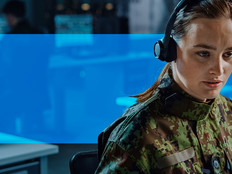The Top Common Audio and Videoconferencing Problems
Before the coronavirus pandemic led to a dramatic increase in the number of users teleworking, federal agencies had incorporated audio and videoconferencing into various aspects of their work environments. The Veterans Affairs Department is using telehealth services to allow doctor visits with patients who may live too far from a VA site to come in person for a consultation. Agencies might use videoconferencing to interview job candidates or bolster their customer service.
“Videoconferencing used to be this high-end thing that people would only use in boardrooms,” Wharton said during a recent video interview via Zoom. “But now we’re using it every day.”
In this environment, the need to address system glitches, performance hiccups and networking issues has grown more crucial. It’s not just annoying; it can impede communication and disrupt people trying to do their jobs in a remote location.
It comes down to the weaknesses and quirks of Wi-Fi services, networks and hardware. Even the most sophisticated platforms are only as good as the digital highways that transfer the visual and audio data that they take in.
As a white paper from Poly notes, teleconferencing and videoconferencing services suffer delays and interruptions primarily because of four main issues. The first is latency, or network delay, which “equates to the time between when a person makes a sound and when the person on the other end of a call hears that sound” or “the time between when a gesture is made on camera and when the other participants see it happen on their screens.”
Then, there is packet loss, in which data packets are discarded or dropped because of outdated packets, data corruption from interference, poor Wi-Fi signal strength, network configurations and other reasons.
“The goal of every network design and operation is to have 0 percent average packet loss,” the white paper notes. “On a call without any corrective features (such as Poly’s LPR), packet losses going over 1 percent may start to become noticeable by participants, and at 5 percent audio quality degrades significantly and video (people or content) is generally unusable.”
Sign up for free to become an Insider to get exclusive access to the full webinar on delivering valuable meeting experiences to users.
Jitter, or the inconsistency in delays/latency of packets going between two network points, can also affect audio and video calls.
Finally, bandwidth overuse can cause disruptions when individual network segments are being overused or have more packets than they can handle. That leads to packets being delayed, increasing latency and jitter, or packets being rerouted or discarded.
Poly advises network administrators to monitor the network and the attached infrastructure devices (such as switches, routers, cables, wireless access points and firewalls) for their performance and to ensure all network hardware is in proper functioning order. They should invest in bandwidth increases and new network hardware where needed. Admins can ensure quality of service by changing network configuration settings to prefer real-time traffic over other types of traffic and real-time devices (e.g., endpoints, multipoint control units) over other types of devices (e.g., web servers).
There are other tactics admins can take to ensure high quality of service. With “packet interpolation” of audio data, an algorithm in the software figures out what letter or sound didn’t arrive on time and fills in the missing data based on what it would “expect” from the context of the conversation, Wharton explains.
In video, there’s a similar “lost packet recovery” that smooths out choppy movement resulting from dropped data, says Chris Thorson, senior director of global product marketing for Poly. This avoids excessive buffering, which leaves the person on the other end behind.
“I can do some special sauce to make your experience come across like it’s still really good,” Thorson says.
Cloud infrastructure can help Zoom and other platforms expand their server capacity and ease congestion.
As a result, connections are less “flaky” than they used to be, Wharton says. “You don’t get that pixelation going on.”
MORE FROM FEDTECH: How to ensure your VPN can handle work-from-home traffic.
What Are the Different Types of Teleconferencing?
Teleconferencing technology boils down to the equipment — microphones, cameras, headsets and speakers. According to those who sell those devices, they are smarter, smoother and easier to use than ever before.
Audio Teleconferencing
Audioconferencing was the original teleconferencing, replacing the old-fashioned phone call with a web-based connection between remote participants. Today’s technology has greatly improved on the compression/decompression, or CODEC, software that moves audio and video data on a network, Wharton says.
Traditional phone calls sound like AM radio, he says. With cloud services, Zoom and other platforms use high-definition audio CODECs, such as Opus and SILK in Zoom’s case, he says.
“Zoom is like satellite radio,” Wharton says. “It’s crystal clear.”
Logitech and other equipment-makers can also design equipment to cancel echoes in the audio or streamline the volume so one participant isn’t louder than another. Smart audio devices today can distinguish the speaker’s voice and cancel out other noises in the room.
“In order for this to be more mainstream, you can’t have kids screaming or dogs barking,” Wharton says. That same technology also knows to mute the sound of a conference participant typing on a keyboard or crunching a snack. Poly has NoiseBlockAI, which can adjust, for example, to minimize the background clamor of a factory floor while workers attend a videoconference there.
“It would learn the characteristics of that environment,” Thorson says. “I can load things into it. It can learn what I tell it so you can have a better experience.”
As Wharton’s son noted about the Warriors game, this technology beats a face-to-face encounter, when it’s impossible to silence factory noise or loud-talking colleagues nearby.








.png)



